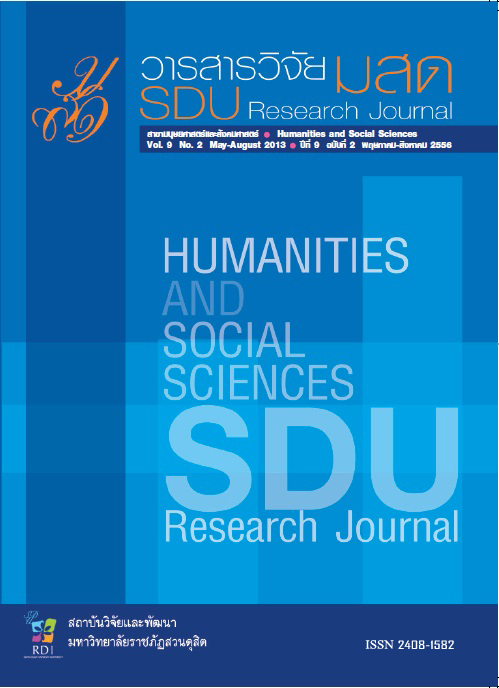โครงสร้างการคิดของนักเรียนชั้นประถมศึกษา
Keywords:
โครงสร้างการคิด, โมเดลความสัมพันธ์เชิงสาเหตุAbstract
บทคัดย่อ
การวิจัยครั้งนี้มีจุดมุ่งหมายเพื่อวิเคราะห์องค์ประกอบและโครงสร้างการคิดของนักเรียนประถมศึกษา กลุ่มตัวอย่างเป็นนักเรียนระดับชั้นประถมศึกษาปีที่ 6 ของโรงเรียนสังกัดสำนักงานคณะกรรมการการศึกษา ขั้นพื้นฐาน (สพฐ.) จำนวน 895 คน เครื่องมือที่ใช้ในการวิจัยคือ แบบวัดการคิดสำหรับนักเรียนระดับชั้นประถมศึกษาปีที่ 6 วิเคราะห์ข้อมูลโดยใช้โปรแกรมสำเร็จรูป SPSSfor Windows,โปรแกรมMULTILOG for Windowsและโปรแกรม LISREL ผลการวิจัยพบว่า
1)แบบวัดการคิดมีองค์ประกอบ ดังนี้ การคิดวิเคราะห์ประกอบด้วย 3 องค์ประกอบ คือ การวิเคราะห์ความสำคัญ การวิเคราะห์ความสัมพันธ์ และการวิเคราะห์หลักการ การคิดสร้างสรรค์ประกอบด้วย 4 องค์ประกอบ คือ ความคิดริเริ่ม ความคิดคล่อง ความคิดยืดหยุ่น และความคิดละเอียดลออ การคิดตัดสินใจ ประกอบด้วย 3 องค์ประกอบ คือ การวิเคราะห์ปัญหา การเปรียบเทียบทางเลือก และการตัดสินใจเลือกทางเลือกการคิดแก้ปัญหา ประกอบด้วย 6 องค์ประกอบ คือ การกำหนดปัญหา การตั้งสมมติฐาน การวางแผนแก้ปัญหา การเก็บรวบรวมข้อมูล การวิเคราะห์ข้อมูลและทดสอบสมมติฐาน และการสรุปผล การคิดแบบวิทยาศาสตร์ ประกอบด้วย 4 องค์ประกอบ คือ การตั้งปัญหา การตั้งสมมติฐาน การทดสอบสมมติฐาน และการตีความหมายและสรุปผลการคิดอย่างมีวิจารณญาณ ประกอบด้วย 6 องค์ประกอบ คือ การนิยามปัญหา การรวบรวมข้อมูล การจัดระบบข้อมูล การตั้งสมมติฐาน การสรุปอ้างอิงโดยใช้ตรรกศาสตร์ และการประเมินสรุปอ้างอิงและอภิปัญญา ประกอบด้วย 3 องค์ประกอบ คือ การวางแผน การตรวจสอบ และการประเมินผล
2)ข้อคำถามในแบบวัดการคิดมีค่าดัชนีวัดความสอดคล้องอยู่ระหว่าง 0.71-1.00 และมีความตรง เชิงโครงสร้าง โดยผลการวิเคราะห์องค์ประกอบเชิงยืนยันอันดับที่สองของโมเดลการวัดการคิดทั้ง 7 โมเดล มีความสอดคล้องกับข้อมูลเชิงประจักษ์
3)โมเดลความสัมพันธ์เชิงสาเหตุการคิดของนักเรียนชั้นประถมศึกษาปีที่ 6มีความสอดคล้องกับข้อมูลเชิงประจักษ์ โดยการคิดแก้ปัญหาได้รับอิทธิพลทางตรงจากการคิดตัดสินใจ การคิดแบบวิทยาศาสตร์ การคิดอย่างมีวิจารณญาณ การคิดวิเคราะห์ และอภิปัญญา และได้รับอิทธิพลทางอ้อมจากการคิดวิเคราะห์และการคิดสร้างสรรค์ และการคิดวิเคราะห์มีอิทธิพลต่ออภิปัญญา การคิดตัดสินใจ การคิดอย่างมีวิจารณญาณ การคิดแบบวิทยาศาสตร์ และการคิดสร้างสรรค์
คำสำคัญ : โครงสร้างการคิด โมเดลความสัมพันธ์เชิงสาเหตุ
Abstract
The purpose of this study was to analyze the factors and structure of elementary school students’ thinking. The samples were 895 upper elementary school students from schools under the Office of the Basic Education Commission. The instrument for data collection was a thinking test for grade six students. The data were analyzed using SPSS for windows, the MULTILOG for Windows, and the LISREL program. The findings were as follows:
1)The factors of the thinking test concerning:
a) analytical thinking consisting of three dimensions: element, relationship, and principles;
b) creative thinking consisting of four dimensions: originality, fluency, flexibility, and elaboration;
c) decision making consisting of three dimensions: analyze the problem, compare select the alternative, and the alternative;
d) problem solving thinking consisting of six dimensions: problem finding, hypothesis, planning, data collection, data analyze, and hypothesis testing and summarizing;
e) scientific thinking consisting of four dimensions: problem finding, formulating hypothesis, hypothesis testing, and interpreting data;
f) critical thinking consisting of six dimensions: problem finding, data collection, classifying data, formulating hypothesis, logical inference, and evaluating; and
g) metacognition consisting of three dimensions: planning, monitoring and evaluating.
2) the items of the thinking test indicated an objective congruence index between 0.71 – 1.00, whereas the construct validities of the test were supported by a second order factor analysis of 7 thinking models fit to the empirical data.
3) the Causal Relationship Model of thinking of grade six students was valid and fit to the empirical data.
The results showed that the factors had a direct effect on problem solving thinking regarding decision making, scientific thinking, critical thinking, analytical thinking, metacognition, and indirect effect that is analytical thinking and creative thinking. In addition, findings indicated that analytical thinking had a direct effect on metacognition, decision making, critical thinking, scientific thinking, and creative thinking.
Keywords : structure of thinking, cause and effect model








